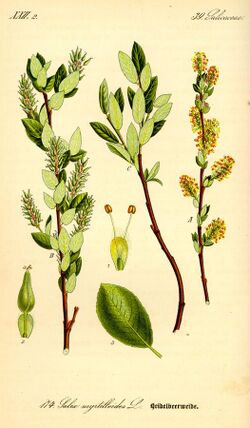Biology:Salix breviserrata
| Salix breviserrata | |
|---|---|

| |
| Scientific classification | |
| Kingdom: | Plantae |
| Clade: | Tracheophytes |
| Clade: | Angiosperms |
| Clade: | Eudicots |
| Clade: | Rosids |
| Order: | Malpighiales |
| Family: | Salicaceae |
| Genus: | Salix |
| Species: | S. breviserrata
|
| Binomial name | |
| Salix breviserrata B. Flod., 1940
| |
| Synonyms[1] | |
| |
Salix breviserrata is a species of willow belonging to the family Salicaceae. It is found in southern Europe in the Alps, and in the Iberian Peninsula in the Cantabrian Mountains, especially in the Picos de Europa, Somiedo, and the Sierra and Valle del Híjar (Campoo Valley).
Taxonomy
The species was described by Björn Floderus and published in Arkiv för Botanik 29A (18):. 41, in obs, 44 , in 1940.[2][3]
Description
It is a shrub that reaches a size of 0.1-0.2 (0.4) m in height, ± creeping. The gnarled branches, glabrescent at first, then glabrous, reddish-brown or grayish-brown. The leaves are 2 (5) × 1-2 cm, lanceolate to elliptical or transovate-lanceolate, acute or more rarely obtuse at the apex, rounded or shortly attenuated at the base, with the margin toothed-serrated, glandular, upper side and underside normally glabrous, sometimes hairy, green and shiny, without glaucescence on the underside, with 3-5 pairs of secondary nerves, prominent on both sides; petiole short, less than 0.5 cm; stipules ovate-lanceolate, equal-sided, sharply serrated, sometimes absent. Catkinsup to 3 × 1 cm, contemporaneous, sometimes late, terminal or subterminal, on long peduncles, with foliaceous bracts and hairy rachis; floral bracts transovate, with the apex obtuse, dark, pubescent. Flowers with a violet nectarium; the masculine ones with 2 stamens, with free filaments, glabrous, and purple or black anthers, then violaceous; the female ones with a subsessile or sessile pistil, tomentose, glabrescent at maturity, purple or red-violet, long, purple in style, and purple bifid stigmas.[4]
References
- ↑ "Oldstyle id: 5f90af7dd2d39606ea6f751730f1a77c". Species 2000: Naturalis, Leiden, the Netherlands. http://www.catalogueoflife.org/col/details/species/id/5f90af7dd2d39606ea6f751730f1a77c.
- ↑ Salix breviserrata at Trópicos
- ↑ Salix breviserrata at PlantList
- ↑ Salix breviserrata at Flora Vascular
Wikidata ☰ Q6117332 entry
 |

